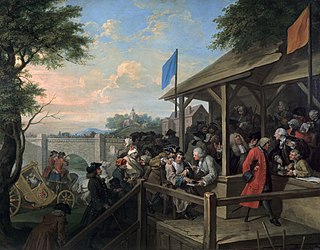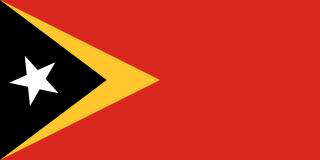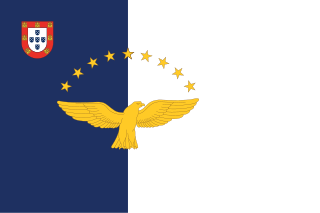
The national flag of France is a tricolour featuring three vertical bands coloured blue, white, and red. It is known to English speakers as the Tricolour, although the flag of Ireland and others are also so known. The design was adopted after the French Revolution, where the revolutionaries were influenced by the horizontally striped red-white-blue flag of the Netherlands. While not the first tricolour, it became one of the most influential flags in history. The tricolour scheme was later adopted by many other nations in Europe and elsewhere, and, according to the Encyclopædia Britannica has historically stood "in symbolic opposition to the autocratic and clericalist royal standards of the past".

"A Portuguesa" is the national anthem of Portugal. The song was composed by Alfredo Keil and written by Henrique Lopes de Mendonça during the resurgent nationalist movement ignited by the 1890 British Ultimatum to Portugal concerning its African colonies. Used as the marching song of the failed republican rebellion of January 1891, in Porto, it was adopted as the national anthem of the newborn Portuguese Republic in 1911, replacing "Hino da Carta", the anthem of the deposed constitutional monarchy.

Pan-African colours is a term that may refer to two different sets of colours:

The national flag of Brazil, is a blue disc depicting a starry sky spanned by a curved band inscribed with the national motto "Ordem e Progresso", within a yellow rhombus, on a green field. It was officially adopted on 19 November 1889 — four days after the Proclamation of the Republic, to replace the flag of the Empire of Brazil. The concept was the work of Raimundo Teixeira Mendes, with the collaboration of Miguel Lemos, Manuel Pereira Reis and Décio Villares.

The national flag of Benin is a flag consisting of two horizontal yellow and red bands on the fly side and a green vertical band at the hoist. Adopted in 1959 to replace the French Tricolour, it was the flag of the Republic of Dahomey until 1975, when the People's Republic of Benin was established. The new regime renamed the country and changed the flag to a green field with a red star in the canton. This version was utilized until multi-party democracy was re-established in 1990, coinciding with the Revolutions of 1989. The new government promptly restored the original pre-1975 flag.

Political colours are colours used to represent a political ideology, movement or party, either officially or unofficially. They represent the intersection of colour symbolism and political symbolism. Politicians making public appearances will often identify themselves by wearing rosettes, flowers, ties or ribbons in the colour of their political party. Parties in different countries with similar ideologies sometimes use similar colours. As an example the colour red symbolises left-wing ideologies in many countries, while the colour blue is often used for conservatism, the colour yellow is most commonly associated with liberalism and right-libertarianism, and Green politics is named after the ideology's political colour. The political associations of a given colour vary from country to country, and there are exceptions to the general trends, for example red has historically been associated with Christianity, but over time gained association with leftist politics, while the United States differs from other countries in that conservatism is associated with red and liberalism with blue. Mass media has driven a standardization of colour by political party, to simplify messaging, while historically the colour a candidate chose to identify with could have been chosen based on other factors such as family or regional variations.

The flag of Portugal is the national flag of the Portuguese Republic. It is a rectangular bicolour with a field divided into green on the hoist, and red on the fly. The lesser version of the national coat of arms of Portugal is centered over the colour boundary at equal distance from the upper and lower edges. Its presentation was done on 1 December 1910, after the downfall of the constitutional monarchy on 5 October 1910. However, it was only on 30 June 1911, that the official decree approving this flag as the official flag was published. This new national flag for the First Portuguese Republic, was selected by a special commission whose members included Columbano Bordalo Pinheiro, João Chagas and Abel Botelho. The conjugation of the new field color, especially the use of green, was not traditional in the Portuguese national flag's composition and represented a radical republican-inspired change that broke the bond with the former monarchical flag. Since a failed republican insurrection on 31 January 1891, red and green had been established as the colours of the Portuguese Republican Party and its associated movements, whose political prominence kept growing until it reached a culmination period following the Republican revolution of 5 October 1910. In the ensuing decades, these colours were popularly propagandised as representing the hope of the nation (green) and the blood of those who died defending it (red), to endow them with a more patriotic and dignified, therefore less political, sentiment.

The national flag of East Timor is one of the official symbols of East Timor. It consists of a red field with the black isosceles triangle based on the hoist-side bearing a white five-pointed star in the center superimposed on the larger yellow triangle, also based on the hoist-side, that extends to the center of the flag.

The flag of Equatorial Guinea was adopted on August 21, 1979. The six stars on the flag represent Equatorial Guinea's mainland and five islands. Under the rule of dictator Francisco Nguema the flag was modified and a different national emblem was used in it. After he was deposed the original flag was restored.

The flag of São Tomé and Príncipe consists of a red triangle situated at the hoist, with three horizontal green, yellow and green bands charged with two five-pointed black stars of Africa at the centre. Adopted in 1975 to replace the flag of Portugal from the colonial period, it has been the flag of the Democratic Republic of São Tomé and Príncipe since the country gained independence in that same year. The design of the present flag was inspired by and is almost identical to the flag of the Movement for the Liberation of São Tomé and Príncipe.

In military organizations, the practice of carrying colours, standards, flags, or guidons, both to act as a rallying point for troops and to mark the location of the commander, is thought to have originated in Ancient Egypt some 5,000 years ago. The Roman Empire also made battle standards reading SPQR a part of their vast armies. It was formalized in the armies of Europe in the High Middle Ages, with standards being emblazoned with the commander's coat of arms.

The 5 October 1910 revolution was the overthrow of the centuries-old Portuguese monarchy and its replacement by the First Portuguese Republic. It was the result of a coup d'état organized by the Portuguese Republican Party.

The national emblem of East Timor is one of the national symbols of East Timor.

The Flag of the Azores is the regional flag of the Portuguese Autonomous Region of the Azores. It is a rectangular bicolour with a field unevenly divided into blue on the hoist, and white on the fly.

The Newfoundland Tricolour, or the Pink, White and Green, is an unofficial flag seen in the Canadian province of Newfoundland and Labrador, and is mistakenly believed to have been an official Flag of Newfoundland and Labrador, or more commonly, of the island of Newfoundland specifically.

The Efígie da República is used as a national personification, both in Brazil and in Portugal, symbolizing the Republic.

The flag of the Second Spanish Republic, known in Spanish as la tricolor, was the official flag of Spain between 1931 and 1939 and the flag of the Spanish Republican government in exile until 1977. Its present-day use in Spain is associated with the modern republican movement, different trade unions and various left-wing political movements.

The flag of Roraima is one of the official symbols of the state of Roraima in Brazil.

The flag of Pernambuco is one of the official symbols of the Brazilian state of Pernambuco. It is a bicolor pennant, blue and white, with the colors broken horizontally into two unequal sections, with blue in the upper and larger rectangle, the rainbow composed of three colors, red, yellow and green, with a star in above and below the sun, inside the semicircle, both in yellow, and, in the lower and smaller white rectangle, a red cross.



















